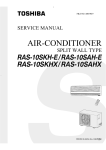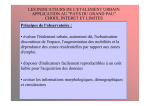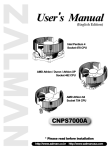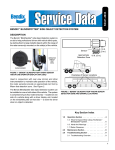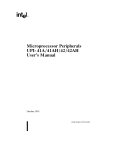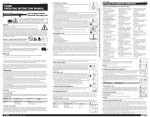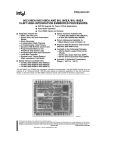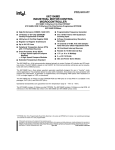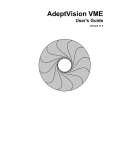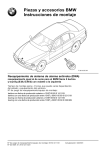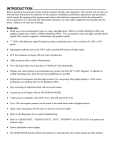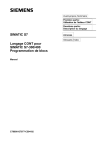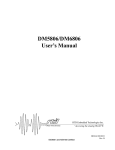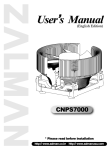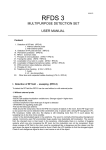Download Intel 82557 to 82596 Compatibility Guide
Transcript
AP-368 APPLICATION NOTE 82557 10/100 Mbps PCI LAN Controller A Guide to 82596 Compatibility Technical Marketing Network Products Division November 1995 Order Number: 644126-001 Information in this document is provided in connection with Intel products. Intel assumes no liability whatsoever, including infringement of any patent or copyright, for sale and use of Intel products except as provided in Intel’s Terms and Conditions of Sale for such products. Intel retains the right to make changes to these specifications at any time, without notice. Microcomputer Products may have minor variations to this specification known as errata. *Other brands and names are the property of their respective owners. ² Since publication of documents referenced in this document, registration of the Pentium, OverDrive and iCOMP trademarks has been issued to Intel Corporation. Contact your local Intel sales office or your distributor to obtain the latest specifications before placing your product order. Copies of documents which have an ordering number and are referenced in this document, or other Intel literature, may be obtained from: Intel Corporation P.O. Box 7641 Mt. Prospect, IL 60056-7641 or call 1-800-879-4683 COPYRIGHT © INTEL CORPORATION, 1996 82557 10/100 Mbps PCI LAN CONTROLLER A GUIDE TO 82596 COMPATIBILITY CONTENTS PAGE 1.0 INTRODUCTION ÀÀÀÀÀÀÀÀÀÀÀÀÀÀÀÀÀÀÀÀÀÀÀ 1 2.0 THE 82557 LAN CONTROLLER ÀÀÀÀÀÀÀ 1 3.0 FEATURE CHANGES IN THE 82557 ÀÀÀÀÀÀÀÀÀÀÀÀÀÀÀÀÀÀÀÀÀÀÀÀÀÀÀÀÀÀÀÀÀÀÀ 2 4.0 FUNCTIONAL CHANGES BETWEEN THE 82557 AND 82596 ÀÀÀÀÀÀÀÀÀÀÀÀÀÀÀÀÀÀ 2 4.1 New Enhancements in the 82557 ÀÀÀÀÀÀÀÀÀÀÀÀÀÀÀÀÀÀÀÀÀÀÀÀÀÀÀÀÀÀÀÀ 2 4.2 Functions in the 82596 Not Supported by the 82557 ÀÀÀÀÀÀÀÀÀÀÀÀÀÀÀ 3 CONTENTS PAGE 5.0 SOFTWARE INTERFACE COMPARISONS ÀÀÀÀÀÀÀÀÀÀÀÀÀÀÀÀÀÀÀÀÀÀÀÀÀ 3 5.1 The 82557 Control Status Register (CSR) ÀÀÀÀÀÀÀÀÀÀÀÀÀÀÀÀÀÀÀÀÀÀÀÀÀÀÀÀÀÀÀÀÀ 3 5.2 SCB Command Comparisons ÀÀÀÀÀÀÀÀ 7 5.3 SCB Status/Acknowledge Comparisons ÀÀÀÀÀÀÀÀÀÀÀÀÀÀÀÀÀÀÀÀÀÀÀÀÀ 8 5.4 Action Command Comparisons ÀÀÀÀÀÀ 8 5.5 Configure Parameter Differences ÀÀÀÀÀÀÀÀÀÀÀÀÀÀÀÀÀÀÀÀÀÀÀÀÀÀÀ 9 5.6 PORT Interface Comparisons ÀÀÀÀÀÀÀ 11 5.7 Statistical/Error Information Comparisons ÀÀÀÀÀÀÀÀÀÀÀÀÀÀÀÀÀÀÀÀÀÀÀÀ 11 6.0 ADDITIONAL INFORMATION ÀÀÀÀÀÀÀÀ 12 AP-368 1.0 INTRODUCTION Over the last few years, the networking environment has evolved to account for the needs of high-bandwidth. Fast Ethernet,* otherwise known as IEEE 100BASE-T, is a technology derived from 10BASE-T Ethernet and was designed to address many of the performance bottlenecks associated with classic 10 Mbit Ethernet networks. Intel’s Fast Ethernet component product solution includes the 82557 and 82553 components. This application note provides information on the differences between the Intel 82596 and the Intel 82557 next generation family of LAN controllers. It explains 82596 to 82557 compatibility for Ethernet designers. The application note can help designers transition from an existing 82596 LAN solution to an 82557 solution. For further information on the 82557, refer to the 82557 Data Sheet and the 82557 User’s Manual, available from an Intel Sales Representative. 2.0 THE 82557 LAN CONTROLLER of FLASH provides remote Boot capability (a BIOS extension stored in the FLASH which could allow a node to boot itself off of a network drive). For 100 Mbps applications the 82557 contains an IEEE MII compliant interface to the Intel 82553 physical interface device (or other MII compliant PHY) which provides a complete LAN solution for 100/10 Mbps networks. For 10 Mbps networks, the 82557 can be interfaced to a standard ENDEC interface (such as the Intel 82503 Serial Interface component), while maintaining software compatibility to 100 Mbps solutions. The 82557 was designed to implement cost-effective, high-performance PCI add-in adapters, or it can also be used directly on a PC motherboard designs. Its combination of high integration and low cost make it ideal for either application. 82557 Feature Summary # Glueless 32-bit PCI bus master interface (direct drive of bus)Ðcompatible to PCI spec Rev 2.1 # 82596-like chained memory structure # Improved dynamic transmit chaining for enhanced performance The 82557 is Intel’s first highly-integrated 32-bit PCI LAN controller for 10 or 100 Mbps Fast Ethernet networks. The 82557 offers a high performance LAN solution while maintaining low-cost through its high-integration. It contains a high-performance 32-bit PCI Bus Master interface to fully use the high bandwidth available (up to 132 Mbytes per second) to masters on the PCI bus. The 82557 is optimized to support twisted pair Ethernet, the required wiring media for 100BASE-T. The 82557 contains a number of high-performance networking features that off-load time-critical tasks from the CPU. Its bus master architecture can eliminate the ‘‘intermediate copy’’ step in Receive (RCV) and Transmit (XMT) frame copies, resulting in faster processing of these frames. It maintains a similar memory structure to the Intel 82596 LAN Coprocessor, however, these memory structures have been streamlined for better Network Operating System (NOS) interaction and improved performance. The 82557 contains two separate RCV and XMT FIFOs, preventing data overruns or underruns while waiting for access to the PCI bus. The FIFOs also enable back to back frame transmission within the minimum inter-frame spacing. Full support for up to 1 Mbyte # Programmable transmit threshold for improved bus utilization # Early receive interrupt for concurrent processing of receive data # Built-in FLASH interface with addressing up to 1 MByte # On-chip receive and transmit FIFOs # On-chip counters for network management # Support for back to back transmit interframe spacing (IFS) # Built in EEPROM interface # Support for both 10 Mbps and 100 Mbps networks # Interface to MII-compliant physical interface such as the Intel 82553 Serial Component for 10/100 Mbps designsÐIEEE 802.3 100BASE-T compatible # Interface to Intel 82503 for 10 Mbps designsÐIEEE 802.3 10BASE-T compatible # Autodetect and autoswitching for 10 or 100 Mbps network speeds # Full duplex capable at 10 and 100 Mbps # 160 Lead QFP package 1 AP-368 3.0 FEATURE CHANGES IN THE 82557 The 82557 is a follow-on to the 82596 LAN controller. Intel made a number of changes and enhancements in the 82557 to increase performance while being cost sensitive. The following table highlights key functional and physical changes between the 82557 and 82596: Feature 82557 Maximum Serial Speed 10 or 100 Mbps 10 Mbps 82596 MII Yes No Bus Interface 32-Bit PCI 32-Bit Local Bus Bus Bandwidth 132 Mbytes/ Sec. @ 33 MHz 106 Mbytes/ Sec. @ 33 MHz Architecture Master Master Shared Memory Structures CSR, CBL, RFA Initialization Root, SCB, CBL, RFA Transmit/ Receive Structures Simplified, Flexible 82586, Simplified, Flexible Memory Addressing 32-Bit Enhanced Linear 82586, 32-Bit Segmented, Linear FIFO 3K RX, 3K TX 128 Byte RX, 64 Byte TX Byte Ordering Little Endian Little, Big Endian FLASH Interface Yes (1 M) No Package 160-Pin PQFP 132-Pin PQFP, PGA Pin Compatible No No Bursting 256 Dword 4 Dword 4.0 FUNCTIONAL CHANGES BETWEEN THE 82557 AND 82596 This section lists primary functional changes between the 82557 and the 82596. Some are functional enhancements, others are deletions of the 82596 functionality. 2 4.1 New Enhancements in the 82557 # FIFO size: the 82557 includes independent on-chip Transmit and Receive FIFOs (3 Kbytes each); the 82596 includes 64 byte transmit and 128 byte receive on-chip FIFOs. # General chip control structure changes: in the 82557, an on-chip CSR structure incorporates SCB, Flash/EEPROM and MDI registers. In the 82596, the shared memory SCB, ISCP, and SCP structures were used for general chip control. # Operational speed flexibility: the 82557 supports either 10 or 100 Mbit operation. The 82596 supports a 10 Mbit operation only (ignoring full duplex functionality in both). # Reset functionality: the 82557 includes a selective reset command which specifically resets CU and RU without affecting the overall device configuration. The 82596 includes the CUÐABORT command which terminates the current CU activity and returns the CU to a known (Idle) state. # DMA resource tuning: in the 82557, Tx and Rx DMA preempt counts allow direct manipulation of DMA resources to reflect design biases towards either transmit or receive functions. The 82596 has a fixed priority scheme for managing DMA resources. # Statistical counters: the 82557 contains 16 on-chip statistical counters that are automatically updated with each transmit/receive command. The 82596 TCB stores statistical data which must be compiled by the driver for each TCB before continuing to the next command. # MII: the 82557 supports MII interface compatibility (includes MII specific control and data signals and MDI register). The 82596 includes a generic ENDEC serial interface. # PCI: the 82557 includes a full 32-bit PCI standard interface. The 82596 includes a 32-bit local bus interface. # Bus throughput: the 82557 allows a 132 Mbyte maximum parallel (PCI) bandwidth at 33 MHz. The 82596 allows a 106 Mbyte maximum parallel bandwidth at 33 MHz. # Flash capable: the 82557 allows for a flash memory interface (control and addressing up to 1 Mbyte). The 82596 does not allow for designs requiring flash memory devices. # Full duplex: the 82557 is truly Full duplex capable using FDX and FULHAL pins for controlling full duplex functionality. The 82596 implements a limited full duplex capability. AP-368 # Adaptive IFS: the 82557 supports an adaptive IFS algorithm which maximizes network throughput. The 82596 includes a tunable IFS parameter for manually adjusting IFS. # Bursting: the 82557 allows bursting of 256 Dword lengths. The 82596 allows bursting of 4 Dword length. # Early Transmit Completion Status: the 82557 reports a completion of a transmit command as soon as the frame is copied from memory so that the driver can reuse resources to prepare a new transmit command. # Transmit threshold: the 82557 incorporates a transmit threshold parameter which allows adjustment to the FIFO level at which the Transmit process begins. The 82596 begins the Transmit process as soon as the first Dword reaches the bottom of the transmit FIFO. # Addressing modes: the 82557 uses an enhanced linear addressing mode for all operations. The 82596 uses either linear or 32-bit segmented (82586) addressing modes. 4.2 Functions in the 82596 not Supported by the 82557 5.0 SOFTWARE INTERFACE COMPARISONS Both the 82557 and 82596 use a shared memory communication system with the CPU. However, the 82557 uses only three parts that comprise the shared memory structure: Control/Status Registers (CSR), Command Block List (CBL), and the Receive Frame Area (RFA). The 82596 memory structure is divided into four parts: the Initialization Root, the System Control Block, the Command Block List, and the Receive Frame Area. One of the main differences in the 82557 and 82596 memory structures is the 82557 System Control block (SCB) residing on-chip (accessed by either I/O or memory cycles) as part of the Control Status Register (CSR). In the 82596, the channel attention signal is used by the 82596 to access the System Configuration Pointer (SCP) and the Intermediate System Configuration Pointer (ISCP). The ISCP then points to the SCB (see Figure 2). However, the SCB serves the same purpose in both the 82596 and 82557. It is a central communication point for exchanging control and status information between the CPU and the 82557. The CPU controls the state of the Command Unit (CU) and Receive Unit (RU) (e.g. Active, Suspended or Idle) by writing commands to the SCB. The 82557 and 82596 updates the SCB Status Word to provide status. # Byte Ordering: the 82557 supports Little Endian mode only (no Big Endian mode). # Addressing: the 82557 has no 82586 compatible addressing modes. # Adjustable frame length: the 82557 has no Minimum Frame Length variable (82557 has a default minimum frame length of 64 bytes). # Monitor mode: the 82557 has no monitoring mode for evaluating incoming frames. # Adjustable slot time: the 82557 has no support for an adjustable slot time parameter. # Control structures: the 82557 does not include SCP, SCB or ISCP shared memory structures (on-chip CSR replaces SCB). # CRC: CRC flexibility is not supported in the 82557 (No CRC and CRC-16/CRC-32 options are not present). 5.1 The 82557 Control Status Register (CSR) The 82557 CSR registers, MDI, Flash, PORT, MDI Control, and General Pointer allow the CPU to read to and from an EEPROM, FLASH, Management Data Interface (in the case of MDI, Flash, and MDI Control). They also point to various data structures in memory, reset the 82557, etc. (for General Pointer and PORT, respectively). In contrast, the 82596 does not include FLASH or MDI in its SCB; it uses RFA Offset/CBL Offset, as opposed to the 82557 General Pointer. The 82596 also uses T-ON and T-OFF parameters in its SCB, which the 82557 does not use. Additionally, the 82596 uses the PORTÝ pin to allow the CPU to directly access it for certain function, as opposed to the 82557, which has a PORT register within its SCB. 3 AP-368 644216 – 1 Figure 1. 82557 Shared Memory Structure 4 AP-368 644216 – 2 Figure 2. 82596 Shared Memory Structure 5 AP-368 31 Upper Word ACK X CUC R 16 15 RUC 0 0 0 0 Lower Word STAT 0 CUS RFA OFFSET RUS 0 T 0 0 0 CBL OFFSET CRC ERRORS ALIGNMENT ERRORS RESOURCE ERRORS OVERRUN ERRORS RCVCDT ERRORS SHORT FRAME ERRORS T-ON TIMER T-OFF TIMER Figure 3. 82596 System Control Block 31 Upper Word 16 15 SCB Command Word Lower Word 0 SCB Status Word SCB General Pointer PORT EEPROM Control Register Flash Control Register MDI Control Register Figure 4. 82557 Control Status Register The 82557 Command Block List (linked list of individual action commands) and Receive Frame Area (list of free frame descriptors and data buffers) are very similar to those of the 82596. Transmit commands can be programmed in either Simplified or Flexible memory modes. The Receive Frame Area consists of Receive Frame Descriptors (RFDs) and Receive Buffer De- 6 scriptors (RBDs). The 82596 RFD can be one two types: Simplified or Flexible. For the 82557, its RFD can be one of three types: Simplified, Flexible, or Header. Detailed memory structure differences are highlighted in Sections 5.2 through 5.7. AP-368 5.2 SCB Command Comparisons 82557 Type of Command CPU Acknowledge Events Interrupt Control CU Commands RU Commands Other Op Code N/A Parameter Acknowledge events are located in SCB Status word 82596 Op Code Parameter N/A CX: CU completed action command N/A FR: RU received a frame N/A CNA: Command Unit became not active N/A RNR: Receive Unit became not ready N/A N/A (Need external latch) 1 Software Generated Interrupt 1 Interrupt Mask bit 000 NOP 000 NOP 001 CU Start 001 CU Start 010 CU Resume 010 CU Resume 011 Reserved 011 CU Suspend 100 Load Dump Counters Address 100 CU Abort 101 Dump Statistical Counters 101 110 Load CU Base 111 Dump and Reset Statistical Counters Load Bus Throttle Timers Load & restart Bus Throttle Timers 111 Reserved 000 NOP 000 NOP 001 RU Start 001 RU Start 010 RU Resume 010 RU Resume 011 Reserved 011 RU Suspend 100 RU Abort 100 RU Abort 101 Load Header Data Size 101 Reserved 110 Load RU Base 110 Reserved 111 RBD Resume 111 Reserved N/A Must use PORT reset N/A Reset (logically same as hardware RESET) 7 AP-368 5.3 SCB Status/Acknowledge Comparisons Type of Status 82557 Interrupt Acknowledgment CU Status RU Status 82596 CX/TNO: CU finished executing a command with ‘‘I’’ bit set, or indicates transmit command ended NOT OK. (configurable) CX: CU finished executing a command with its ‘‘I’’ bit set. FR: RU finished receiving the frame, or header part of frame. FR: RU finished receiving a frame. CNA: Command unit left the Active state and entered the idle state. (configurable) CNA: Command unit left the active state. RNR: Receive unit left the Ready state. RNR: Receive unit left the Ready state. MDI: MDI read or write cycle is completed. (configurable) N/A SWI : Software generated interrupt. N/A Idle Idle Suspended Suspended Active Active Idle Idle Suspended Suspended No Resources No Resources Ready Ready Suspended with no more RBDs N/A No resources due to no more RBDs No resources due to no more RBDs Ready with no RBDs present Ready with no RBDs present 5.4 Action Command Comparisons Type of Command Action Commands 8 Op Code 82557 Op Code 82596 000 NOP 000 NOP 001 Individual Address Setup 001 Individual Address Setup 010 Configure 010 Configure 011 Multicast Address Setup 011 Multicast Address Setup 100 Transmit 100 Transmit 101 Reserved 101 TDR 110 Dump 110 Dump 111 Diagnose 111 Diagnose AP-368 5.5 Configure Parameter Differences Parameters Configure Command Parameters FIFO/DMA Parameters Statistical/Error Parameters IEEE Parameters Op Code 82557 010 Op Code 82596 010 RX FIFO Limit FIFO Limit TX FIFO Limit FIFO Limit RX DMA Max. Byte Count N/A TX DMA Max. Byte Count N/A DMA Max. Byte Count Enable N/A Save Bad Frames Save Bad Frames Discard Short Receive Frames N/A (use Min. Frame length) RCV CRC Transfer N/A N/A No CRC Insertion N/A CRC-16/CRC-32 N/A CRC in Memory N/A Monitor Bits N/A Monitor Linear Priority Linear Priority Interframe Spacing Interface Spacing Broadcast Disable Broadcast Disable Promiscuous Mode Promiscuous Mode Linear Priority Mode N/A No Source Address Insertion No Source Address Insertion N/A Backoff Method N/A Slot Time N/A Maximum Retry Number N/A Disable Backoff N/A Exponential Priority 9 AP-368 5.5 Configure Parameter Differences (Continued) Parameters Collision Parameters Header Parameters Other 10 Op Code 82557 Op Code 82596 CRS or CDT N/A N/A Carrier Sense Filter N/A Carrier Sense Source N/A Collision Detect Filter N/A Collision Detect Source N/A Transmit on no CRS N/A Collision Detect by Source Address Comparison N/A Address Length N/A (use discard short frames) Minimum Frame Length Multicast ALL Multicast ALL Multiple Individual Address Multiple Individual Address N/A Preamble Until Carrier Sense Preamble Length Preamble Length Adaptive IFS N/A Late SCB Update N/A Transmit Not OK Interrupt N/A CU Idle Interrupt N/A Underrun Retry N/A 503/MII N/A Loopback Loopback N/A Manchester/NRZ Stripping Enable N/A Padding Enable N/A N/A Bit Stuffing N/A Padding (for Bit Stuffing) N/A Auto Retransmit Byte Count Byte Count Force Full Duplex Full Duplex Operation Full Duplex Pin Enable Full Duplex Operation AP-368 5.6 PORT Interface Comparisons 82557 82596 Software Reset Software Reset Self-Test Self-Test Selective Reset N/A (must use CU/RU Abort) Dump Dump N/A SCP 5.7 Statistical/Error Information Comparisons 82557 Statistical/Error 82596 Location in Memory/On-Chip Statistical/Error Location in Memory/On-Chip Transmit Good Frames on chip counter N/A N/A Transmit Maximum Collisions Errors on chip counter Transmit Maximum Collisions (number of collisions experience per frame; used with Transmit Attempt Stopped) in TCB (per frame) N/A N/A Transmit Attempt Stopped (stopped because number of collisions exceeded max. number of retries) in TCB (per frame) Transmit Late Collisions Errors on chip counter/in TCB Transmit Late Collision in TCB (per frame) Transmit Underrun Errors on chip counter Transmit Underrun in TCB (per frame) Transmit Lost Carrier Sense on chip counter Transmit Lost Carrier Sense in TCB (per frame) Transmit Deferred on chip counter Transmit Deferred in TCB (per frame) Transmit Single Collisions on chip counter Use Transmit Max. Collisions Transmit Multiple Collisions on chip counter Transmit Total Collisions on chip counter Receive Good Frames on chip counter N/A N/A Receive CRC Errors on chip counter Receive CRC Errors in SCB Receive Alignment Errors on chip counter Receive Alignment Errors in SCB Receive Resource Errors on chip counter Receive Resource Errors in SCB Receive Overrun Errors on chip counter Receive Overrun Errors in SCB Receive Collision Detect Errors on chip counter Receive Collision Detect Errors in SCB Receive Short Frame Errors on chip counter Receive Short Frame Errors in SCB N/A N/A Heartbeat Indicator in TCB (per frame) N/A N/A Transmit lost Clear to Send in TCB (per frame) 11 AP-368 6.0 ADDITIONAL INFORMATION For additional literature contact your local Intel sales office or contact the Intel Literature Center by calling 1-800-548-4725. If you need design information, contact your local Intel Field Applications Engineer. 12
















